Unveiling the Beauty of Mount Kenya National Park: A Complete Travel Guide
Welcome to the Mount Kenya National Park travel guide, your ultimate resource for exploring one of Africa's most iconic destinations. It is a UNESCO World Heritage site nestled in the central highlands of Kenya with diverse ecosystems, stunning landscapes, and a variety of wildlife. Mount Kenya offers a wealth of memorable experiences, whether you're a nature lover, avid hiker, or wildlife enthusiast
From the summit of Africa’s second-highest peak, you can see other towering mountains, lush wilderness, and pristine lakes, all offering something to suit everyone. In this guide, you will learn everything you need to know about planning your visit to this beautiful park, when it is the best time to visit, what activities you should try there, and what the travel tips are. It is a park that offers a lifetime adventure at Mount Kenya!

Mount Kenya National Park supports a unique Afro-alpine ecosystem, and it serves as a crucial drainage basin that supplies Kenya’s water.
- Where is Mount Kenya National Park located?
- Best time to visit Mount Kenya National Park
- How to get to Mount Kenya national park?
- Mount Kenya National Park Entrance Fees: Your Essential Guide to Pricing
- Exploring the Main Gates of Mount Kenya National Park: A Visitor’s Guide
- Things to Do in Mount Kenya National Park: A Guide to the Best Activities
- Top Travel Tips for Exploring the Wonders of Mount Kenya National Park
- Conclusion
Where is Mount Kenya National Park located?
Mount Kenya National Park is situated in central Kenya, approximately 150 kilometers north of Nairobi, the capital. Mount Kenya National Park encircles Africa’s second-highest peak, Mount Kenya, which is the second-highest mountain at 5,199 meters (17,057 feet). The park forms an extension of the Mount Kenya forest reserve and is located in the central area of the country and cuts across Kirinyaga, Nyeri, Meru, and Embu counties.
It is a UNESCO World Heritage Site, renowned for its rich biodiversity and distinct landscapes, with a rich culture. Various kinds of ecosystems, which include tropical forests, alpine meadows, and glaciers, are found in the park, which houses a wide range of wildlife like elephants, buffaloes, and bird species. It is centrally located, therefore an attraction spot to adventure lovers and nature lovers who may engage in activities such as hiking, camping endeavors, and viewing of the wildlife.
Best time to visit Mount Kenya National Park
The best time to visit Mount Kenya National Park largely depends on the kind of experience you’re seeking. The park experiences two distinct seasons – dry and rainy throughout the year. Daylight lasts about 12 hours year-round, with sunrise and sunset times remaining fairly constant.
Dry Season (Peak & Shoulder Periods)
- Peak Dry Season: January–February and July–September – the most popular months for climbing Mount Kenya, hiking, and wildlife viewing. Trails are generally dry, skies are clear, and temperatures are comfortable.
- Shoulder Dry Season: October–December – generally dry with occasional light showers; green landscapes and migratory birds make it ideal for birdwatching. Fewer crowds than in peak months.
Rainy Season
- Long Rain Season: March–June – When heavy rain causes trails to become slick and sometimes closed. Nonetheless, if rain does bother you less too, this season boasts of very minimal tourists who come to read a book in solitude.
- Short Rain Season (November-December) – green landscapes and migratory birds attract people interested in bird watching or the lush vegetation of the park. A little wetter perhaps, but fewer people means a more restful experience.
In summary, for mountain climbing under great, clear-sky conditions, the best months are January–February and July–September. October–December offers a more relaxed experience with some showers, while March–June is best for solitude but least favorable for hiking due to wet conditions.
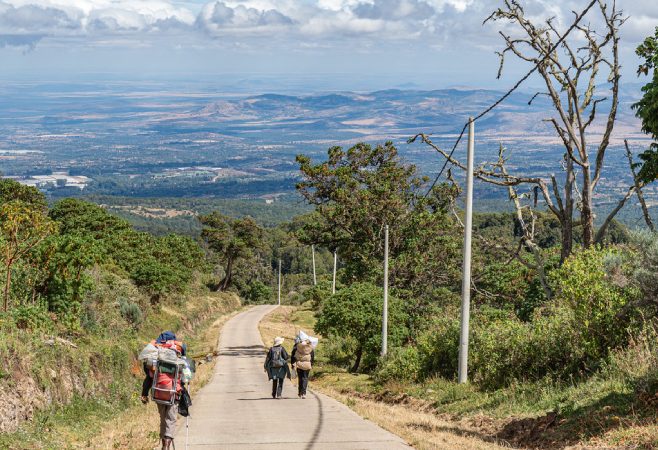
The best time to climb Mount Kenya is during the dry seasons from January to February and July to early October
How to get to Mount Kenya national park?
Mount Kenya National Park is found within the central part of Kenya, and accessing the park is quite easy with a number of transport means based on your preferences and expenditure budget. This is how to get to this historical place:
By Air
Flying into one of the local airports is the fastest way to reach Mount Kenya National Park. The main international airport is Nairobi Jomo Kenyatta International Airport (NBO), and you will get to it on a domestic flight to the nearest airstrip to this park, Nanyuki airstrip. It takes 40-50 minutes by plane. Nanyuki is approximately a 30-40 minute drive to the entrance of the park. Other airlines that fly daily to Nanyuki include Air Kenya and SafariLink.
In case you are coming in via Mombasa, a flight can be taken either to Nanyuki or Nairobi, and subsequently follow on the road.

The fastest way to get to Mount Kenya from Nairobi is by air
By Road
Taking a road trip is another option but this can be more time consuming depending on your point of origin. The park is accessibly located at a distance of 150 km or 3-4 hours drive by road away in Nairobi. The easiest roadway is the one using the Nanyuki Town where the visitors base their tours to Mount Kenya. Nanyuki can be reached in a number of ways:
- Rental Car/Taxi: You can take a trip by car in Nairobi by renting a car or by taxi, which is an affordable, but more comfortable way. To drive to Nanyuki, you just drive through a paved road and along the route you will also see the beauty the route exhibits; particularly as you approach the base of Mount Kenya.
- Public Transport: There are buses (as well as matatus, or shared minibuses) to Nanyuki that leave Nairobi, usually in the Nyamakima area. Traffic might slow down the journey but it is a cheap transport mode, especially to those who are under a low budget. On reaching Nanyuki, you may get a local taxi or book a transfer to the park.
- Self-Drive: If you are an adventurous person, you can hire a car in Nairobi and drive there to the park yourself. The way to Nanyuki outside of Nairobi is paved, however you have to travel the dirt road to the entrance of the park. It is strongly advised that a 4x4 vehicle should be used and most importantly, this is when it is your intention to visit the higher levels of the park
By Train
Rail travel to Nanyuki is available via the restored meter gauge railway, not the Standard Gauge Railway (SGR). The journey from Nairobi to Nanyuki typically takes 6–7 hours and offers a scenic ride through the central highlands. In Nanyuki you may take a taxi or a local driver to bring you to the park entrance.
Getting Around the Park
Once you arrive at Mount Kenya National Park, you can explore its vast trail system of the park, offering both trekking and mountaineering opportunities. he park offers various trails suitable for both amateur walkers and professional mountaineers
The majority of tourists stay in Nanyuki or Nairobi and make a day trip to the park or an extended safari.
In a nutshell, regardless of how you are traveling, by air or by road, Mount Kenya National Park is an easy and unforgettable trip. You can get there quickly by good roads, local transport, and air connections to one of Kenya's most beautiful and iconic parks.
Mount Kenya National Park Entrance Fees: Your Essential Guide to Pricing
As of 2025, the Kenya Wildlife Service (KWS) has set the following entry fees for Mount Kenya National Park, which vary based on visitor status (Citizen/Resident or Non-Resident) and and are charged per person, per day. These fees are applicable to all visitors and are essential for planning your visit.
Mount Kenya National Park Entry Fees (2025)
|
Category |
Citizen (KES) |
Resident (KES) |
Non-Resident (USD) |
| Adult (Daily) | 430 | 430 | 52 |
| Child (Daily) | 215 | 215 | 26 |
Notes:
- Fees are charged daily, not as multi-day packages. If you plan to stay for multiple days (e.g., 3–6 days), you multiply the daily rate by the number of days.
- Rates are based on the latest available information from KWS and are subject to change.
- Additional charges may apply for vehicles, camping, or special activities.
Additional Activity Fees:
- Guided Tours: Up to 4 hours: 1,720 KES; Over 4 hours: 3,015 KES
- Fishing: 1,550 KES per line per day
- Walking Safaris: 1,500 KES per person per day
- Camping Fees: Public Campsite: 200 KES (Citizen/Resident), 20 USD (Non-Resident); Special Campsite: 250 KES (Citizen/Resident), 35 USD (Non-Resident)
- Vehicle Entry Charges:
- Less than 6 seats: KSH.300
- 6-12 seats: KSH.1,030
- 13-24seats: KSH.2,585
- 25-44 seats: KSH.4,050
- 45 seats and above: KSH.5,000
Note: These fees are applicable per day and are subject to change.
Mount Kenya National Park is open year-round. But the entrance and exit gates normally work between 6:00 AM-6:00 PM on a daily basis. It is normally recommended that visitors have a qualified guide with them and should check-in and out at the park office.
Exploring the Main Gates of Mount Kenya National Park: A Visitor’s Guide
Mount Kenya National Park is one of the most renowned national parks in Kenya that appeals to nature tourists and nature trekkers, together with other wildlife enthusiasts. The park has numerous entrances, and all of them have distinct access lines and unique experiences of the grand mountain. There are 8 official trekking routes in total, with 3 of them being the most popular for summit attempts – Naro Moru, Sirimon, and Chogoria.
One of the most important gates to access the park is given below:
Naro Moru Gate
Naro Moru gate is the most popular experience, and it is found on the eastern (south) side of Mount Kenya. It is the local headquarters for the well-known Naro Moru Route that hosts easy access to the lower folds of the mountain. The gate is quite close to the town of Naro Moru, hence convenient to those visiting the gate either through Nairobi or Nanyuki. This circuit is used in accessing the central and southern regions of the park and hence provides a good viewing of wildlife. Naro Moru Route is considered the fastest way to reach the summit, which makes it popular among climbers with limited time.
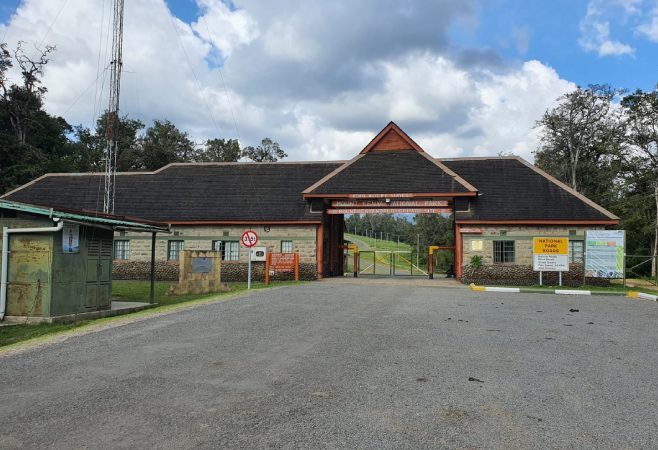
This gate serves as the starting point for the popular Naro Moru trekking route that leads adventurers towards the summit of the iconic mountain.
Kihari Gate
They may also choose the Kihari Gate that is situated on the southern side of Mount Kenya and not far away from the Kihari region. It is a less travelled point of entry, and it has access to some less travelled parts of the park. Kihari Gate is the best place to go when one is not in need of a crazy location and one wants to experience a more calm time without much disturbance and is mostly visited by hikers who want to take off beaten paths to get to the mountain.
Mawingu Gate
Burguret Gate, located near Nanyuki on the western side, is a lesser-used entry point that provides access to quieter hiking trails and remote parts of Mount Kenya National Park. There are more popular gates than it, though it provides access to less crowded scenic routes. The gate opens up into the beautiful scenery of the park, where visitors get access to the rare flora and fauna of Mount Kenya.
Sirimon Gate
Sirimon Gate is one of the most famous gates that leads to Mount Kenya National Park. Located on the west side of the park, it is the beginning of the Sirimon Route that is usually preferred by trekkers and climbers. This gate presents a fairly easy climb towards the summit of the mountain and can accommodate people who want to have a mixture of adventures and convenience. It is equally adequately furnished with tourist amenities, making it a favorite destination for tourists.
Kamweti Gate
Kamweti Gate is one of the gates that are not so commonly used, which is also on the north side of Mount Kenya. It makes accessible the more distant regions of the park, and it offers a more peaceful trip to people who want solitude and feel much closer to nature. Kamweti is a perfect option in the case of more determined hikers who prefer a more wild and authentic trip.
Chogoria Gate
Chogoria Gate is located on the eastern part of Mount Kenya, and it offers remarkable scenery and has difficult trails. This route is widely regarded as the most scenic way to climb Mount Kenya, featuring spectacular landscapes, alpine lakes, and dense forests.. The gate can also be a wonderful jump-off for adventurous persons wishing to get into the dense forests and clear lakes surrounding the mountain peaks.
Things to Do in Mount Kenya National Park: A Guide to the Best Activities
When it comes to nature lovers, adventurers, and wildlife watchers, Mt. Kenya National Park is an awesome site. You can enjoy all kinds of adventure and relaxing experiences in Mount Kenya National Park since there are numerous activities to go to that will make your experience unforgettable. Here are the top seven activities to experience when visiting this UNESCO World Heritage site.
Hiking and Climbing Adventures
Hiking is one of the most popular activities in Mount Kenya national park. The park has various trekking trails of varying difficulty to suit the kind of experience one has and therefore it is suitable to both first time venturers and experienced mountaineers. Sirimon and Naro Moru are the popular tracks that are used in climbing Mount Kenya which is adorned with spectacular sights of alpine plants as well as the various animals found in the parks.
The Batian Peak (the highest point) offers an extreme climbing experience to those who want a harder climb. Hikers can appreciate the natural beauty of the park regardless of the path, with glacial valleys, rock outcrops and rainforests. You can see more Mount Kenya climbing guide
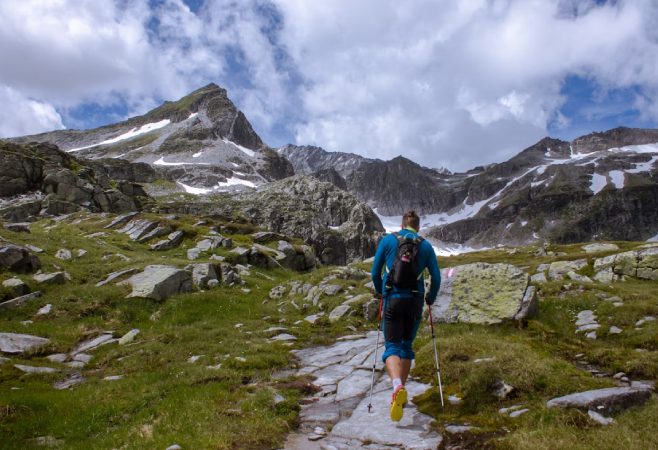
With multiple routes to the summit, the park offers various levels of difficulty, from easier walks to challenging climbs.
Wildlife Viewing
Various animals such as elephants, buffaloes, leopards, and a series of primates can be found at Mount Kenya National Park. Taking a game drive through the park will provide you with an opportunity to view these animals as they are in the wild. There are also various species of birds in the park; thus, it is a birdwatcher's paradise.
Camping at Mount Kenya
One could camp at the park to experience it better. One can use campsites such as Naromoru or Sirimon, where they offer amenities to camp either in a rustic state or a more comfortable one. A night in nature alive with the sounds of the wild and sleeping under the stars is an extra special treat.
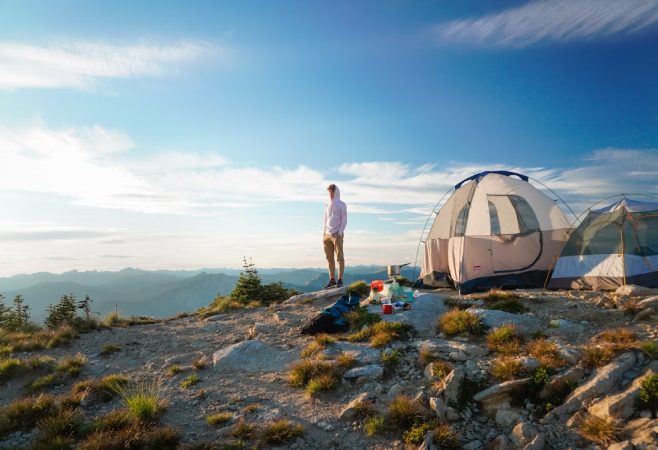
Mount Kenya is one of the best places to camp in Kenya.
Birdwatching
Birdwatching is another activity that should not be overlooked to see over 130 species of birds in the Mount Kenya National Park. There is the dense canopy of the forest down to the expanses of the moorland where you can sight some of the birds, the eagles, the buzzards, and the weavers among others. To maximize the fun you should bring binoculars and a field guide during the birdwatching.
Mountain Biking
To have a more adventurous experience, one would go mountain biking in Mount Kenya National park which is quite an exhilarating experience. There are various bicycle tracks in the park which provide a thrilling adventure to view the area as one enjoys the cool mountain climate and scenic beauty. You can take a ride into forests, grasslands, riding across valleys and all the time enjoy the scenery of the park.
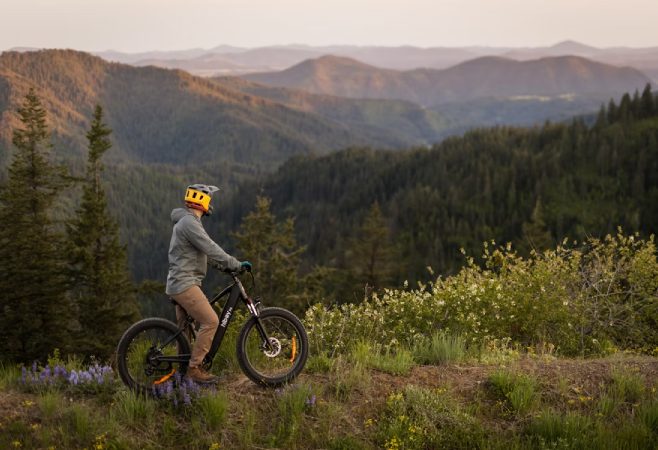
A birdwatching safari in Mount Kenya offers a unique opportunity to spot endemic and rare bird species in breathtaking landscapes.
Game Drives Safari
Mount Kenya National Park is a must-visit as far as wildlife lovers are concerned, especially the safari game drive through the park. The park provides an excellent game driving experience where one can easily find a wide range of animals, such as elephants, buffaloes and antelopes. The wide park offers a less disturbed and less congested safari as compared to other national parks in Kenya. Game drives are available to be booked in several safari lodges found within the park and are one of the great activities to do within Mount Kenya National Park.
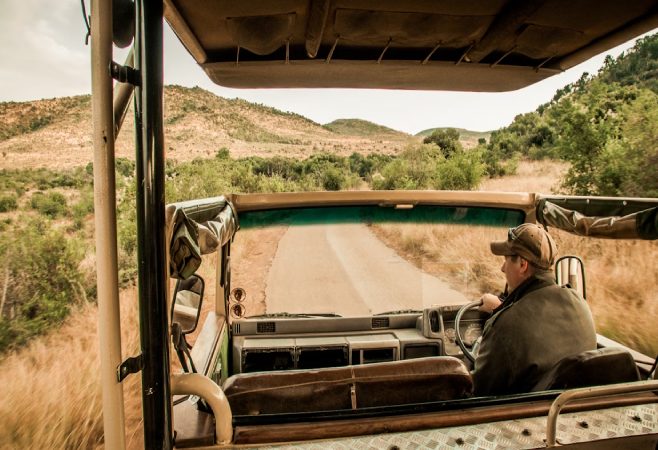
Game drives in Mount Kenya National Park provide an opportunity to explore the diverse wildlife within the park.
Visit the Mau Mau Caves
Visiting the Mau Mau Caves allows one to understand the significance of Mount Kenya in the struggle to become independent in Kenya. The 1950s Mau Mau freedom fighters turned these caves into hideouts. Travelling to this region provides you with an idea of the rich history of this region.
Nithi Falls
A visit to Nithi Falls is a must-do when in Mount Kenya National Park. The falls are on the east side of the mountain and provide spectacular views because the water drops off the cliffs into an abyss of water. It is a perfect place to do photography and nature walks, surrounded by beautiful greenery dotted with serene scenery and a good landscape.
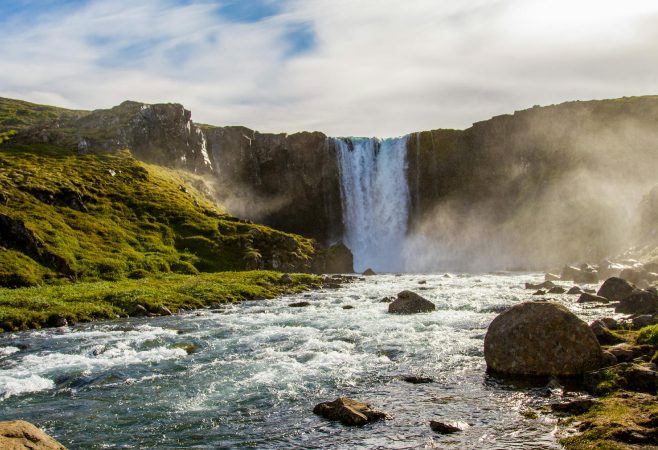
Nithi Falls is a stunning natural oasis that showcases the beauty of Kenya's diverse landscape.
Lake Ellis
Another scenic spot in Mount Kenya National Park is Lake Ellis, located on the eastern slopes near the Chogoria Route, offering peaceful surroundings and beautiful views. The lake is located in the wooded slopes of Mount Kenya and provides serenity to the visitors. You may take it easy and go jogging around the lake, watching the birds or just by the water enjoying the beautiful nature.
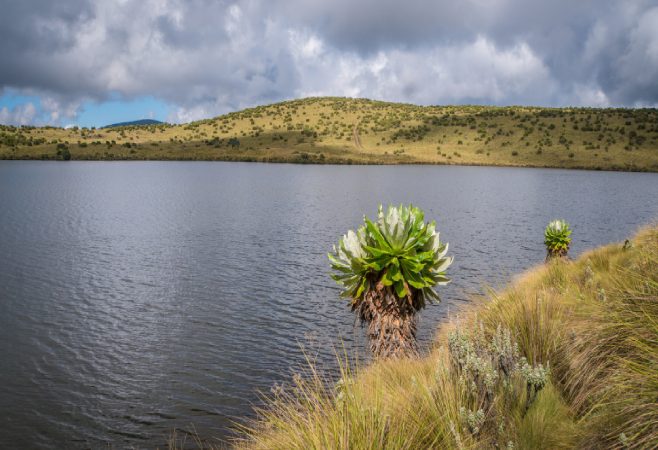
Lake Ellis is a pristine gem offering visitors a tranquil retreat from the bustle of everyday life.
Fishing at Lake Alice
To have a chill off the day, you may fish at Lake Alice, which is found on the lower hills of Mount Kenya. The lake is famous for its large number of rainbow trout and is a serene place to have outdoor engagement. It is an ideal one to get the individuals who want to have a less intensive encounter within the package when they visit the park.
Top Travel Tips for Exploring the Wonders of Mount Kenya National Park
A trip to Mount Kenya National Park is a moment that one would never forget, but in order to make the best out of your visit, there are some key points to consider.
1. Acclimatize to the Altitude
To climbers seeking to make the trek to the top of Mount Kenya, acclimatization to altitude is vital to prevent altitude sickness. Mountains top more than 5,000 meters, and it is advisable to take a few days at lower altitudes within the park and then climb up before making an effort to summit. Begin hiking at low intensity and drink a lot.
2. Bring the Right Gear
The weather in Mount Kenya is uncertain, and hence it is important to pack accordingly. Always bring:
- Warm clothes: The day might be hot; however, at night, the conditions might get very cold (particularly in the higher altitudes).
- Waterproof clothing: Mountain climate is fickle, and rain showers are frequent; therefore, a waterproof jacket and waterproof shoes are essential.
- Good hiking shoes: When hiking, the shoes you wear should be good and fit on bad terrain.
- Sun protection: The high altitude and the sun exposure may bring about sunburn, and one is advised to carry some sunscreen, a wide-brimmed hat, and sunglasses.
3. Book Your Accommodation in Advance
Though there are a number of accommodation facilities within and surrounding the Mount Kenya National Park, it’s advisable to make room reservations in advance during the high season (June to October). Alternatives include the luxury lodges and tented camps and the affordable ones. Always check beforehand to book your tickets so as not to be baffled.
4. eSIM for Connectivity
In order to remain as connected as possible during your visit to Mount Kenya National Park, you may also consider buying an eSIM to ensure a smooth connection. There are providers such as Airalo, GigSky, Truphone & Ubigi that provide cheap data plans to Kenya and allow you to escape the obligation of purchasing a physical SIM card.
Before traveling in-store, you can even activate the eSIM online so when you arrive, you are immediately connected. eSIM services are also available at T-Mobile and Orange in case of travelers out of the U.S. or Europe. Select a provider according to your area and the necessity to be connected to navigate, communicate, and share your experience in real-time.
5. Travel Documents
Before embarking on your trip to Mount Kenya National Park, ensure that you have the following essential travel documents:
- Valid Passport: Your passport must be valid for at least six months beyond your planned departure date from Kenya.
- Kenya Electronic Travel Authorization (ETA): Depending on your nationality, you may require an ETA to enter Kenya. You can apply for the ETA online before your trip, providing a convenient and quick travel authorization
- Yellow Fever Vaccination Certificate: If you are arriving from a country where yellow fever is endemic, you will need to present a Yellow Fever Vaccination Certificate. It is advisable to check the specific vaccination requirements before travel.
- Travel Insurance: Ensure that you have valid travel insurance that covers medical expenses, trip cancellations, and emergencies.
- Flight Tickets and Itinerary: Keep a copy of your flight tickets and travel itinerary, especially if you're part of a guided tour or safari.
- Park Entry Fees Receipt: Make sure you have a copy of your park entrance fee receipt to show at the park gates.
6. Stay Safe and Follow Park Regulations
Never trespass into any specified parks; remember the signs posted and all the rules and regulations governing the parks. When on game drives or hiking across the park, do not go out of marked trails and beware of the presence of wildlife anywhere. The park rangers are in place to assist, so, in case of need, help should be sought.
7. Consider Health Precautions
Mount Kenya National Park is rather safe, though it is recommended to take some health precautions before one decides to visit this area. Be sure to receive all the necessary vaccinations, including yellow fever (in particular, in case of endemic regions). There is also malaria in the region, so discuss with your doctor the need to take malaria prophylaxis medication.
Conclusion
In conclusion, Mount Kenya National Park offers an unforgettable adventure for nature lovers, thrill-seekers, and those looking to experience Kenya’s rich biodiversity and stunning landscapes. Whether you’re hiking to the summit, exploring Lake Ellis, or wandering through lush forests and waterfalls, the park has something for everyone.
By following this travel guide, you’ll be well-prepared for an unforgettable experience. Be sure to plan ahead by securing the necessary documents, obtaining an eSIM for connectivity, and packing accordingly for the park’s diverse activities. Mount Kenya awaits as a truly unique destination, where adventure, nature, and serenity come together in one spectacular setting.
Related Articles
- The Ultimate Foodie’s Guide: The 13 Best Restaurants in Watamu, Kenya
- The Ultimate Guide to Shopping in Mombasa: Markets, Malls & Must-Buy Items
- Explore the Best Hotels in Nyeri: Where to Stay for Comfort and Value
- A Culinary Journey: The 12 Best Restaurants You Need to Try in Westlands, Nairobi
- More Than Just Lake Victoria: A Tourist's Guide to the Best Nightlife Experiences in Kisumu
- The Ultimate Tea Explorer: Discover the 11 best places to visit in Limuru a Quiet Weekend Escape
- From Peaks to Plains: Exploring the 11 Best Places to visit in Kitale for Your Bucket List
- From Luxury to Comfort: A Guide to the Top 14 Hotels in Nakuru for Unforgettable Memories
- A Guide to the Best Cafés and Coffee Shops in Momba for Quality Brews and Unbeatable Vibes
- Dancing Until Dawn: Discovering the Ultimate Nightlife in Mombasa, Kenya











